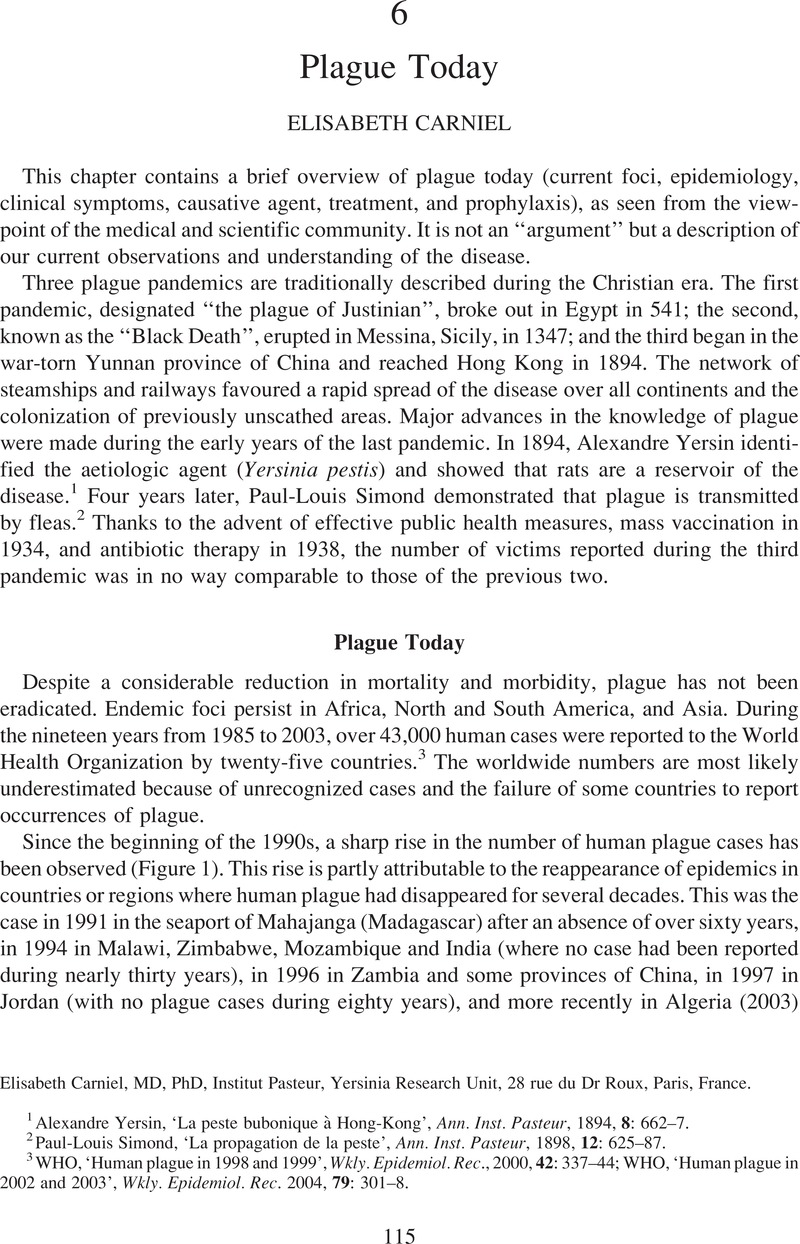Article contents
6 Plague Today
Published online by Cambridge University Press: 16 November 2012
Abstract

- Type
- Articles
- Information
- Medical History , Volume 52 , Supplement S27: Pestilential Complexities: Understanding Medieval Plague , 2008 , pp. 115 - 122
- Copyright
- Copyright © The Author(s) 2008. Published by Cambridge University Press
References
1 Alexandre Yersin, ‘La peste bubonique à Hong-Kong’,Ann. Inst. Pasteur, 1894, 8: 662–7.
2 Paul-Louis Simond, ‘La propagation de la peste’, Ann. Inst. Pasteur, 1898, 12: 625–87.
3 WHO, ‘Human plague in 1998 and 1999’, Wkly. Epidemiol. Rec., 2000, 42: 337–44; WHO, ‘Human plague in 2002 and 2003’, Wkly. Epidemiol. Rec. 2004, 79: 301–8.
4 Stephanie J Schrag and Pamela Wiener, ‘Emerging infectious diseases: what are the relative roles of ecology and evolution?’, Trends Evol. Ecol., 1995, 10 (8): 319–24.
5 A W Bacot and C J Martin, ‘Observations on the mechanisms of the transmission of plague by fleas’, J. Hygiene, 1914, 13 (suppl. 3): 423–39.
6 R J Eisen, S W Bearden, A P Wilder, J A Montenieri, M F Antolin, and K L Gage, ‘Early-phase transmission of Yersinia pestis by unblocked fleas as a mechanism explaining rapidly spreading plague epizootics’, Proc. Natl. Acad. Sci. USA, 2006, 103(42): 15380–85.
7 Suzanne Chanteau (ed.), Atlas de la peste à Madagascar, Paris, IRD, Institut Pasteur, AUF, 2006.
8 Robert Pollitzer, Plague, Geneva, World Health Organization, 1954, pp. 486–90.
9 Chanteau (ed.), op. cit., note 7 above, p. 53.
10 Pollitzer, op. cit., note 8 above, pp. 503–4.
11 Ibid., pp. 409–82.
12 Hervé Bercovier, et al., ‘Intra- and interspecies relatedness of Yersinia pestis by DNA hybridization and its relationship to Yersinia pseudotuberculosis’, Current Microbiology,1980, 4: 225–9.
13 M Achtman, K Zurth, G Morelli, G Torrea, A Guiyoule, and E Carniel, ‘Yersinia pestis, the cause of plague, is a recently emerged clone of Yersinia pseudotuberculosis’, Proc. Natl. Acad. Sci. USA, 1999, 96 (24): 14043–48.
14 S Chanteau, L Rahalison, L Ralafiarisoa, J Foulon, M Ratsitorahina, L Ratsifasoamanana, E Carniel, F Nato, ‘Development and testing of a rapid diagnostic test for bubonic and pneumonic plague’, Lancet, 2003, 361: 211–16.
15 G Girard and J-M Robic, ‘La vaccination de l’homme contre la peste au moyen de bacilles vivants (virus vaccin EV) son application à Madagascar’, Bull. Off. Int. Hyg. Publ. 1936: 28, 1078–87; L Otten, ‘Immunization against plague with live vaccine’, Indian J. Med. Res., 1936, 24: 73–101.
16 M Galimand, A Guiyoule, G Gerbaud, B Rasoamanana, S Chanteau, E Carniel, and P Courvalin, ‘Multidrug resistance in Yersinia pestis mediated by a transferable plasmid’, N. Engl. J. Med., 1997, 337(10): 677–80.
17 B J Hinnebusch, M-L Rosso, T G Schwan, and E Carniel, ‘High-frequency conjugative transfer of antibiotic resistance genes to Yersinia pestis in the flea midgut’, Molecular Microbiology, 2002, 46 (2): 349–54.
18 T Welch, W F Fricke, P F McDermott, D G White, M-L Rosso, et al., ‘Multiple antimicrobial resistance in plague: an emerging public health risk’, PLoS One, 2007, 2(3): e309.
- 9
- Cited by




